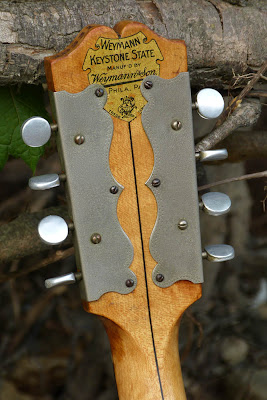c.1915 Weymann 8-String Tenor Banjo
This is maybe the only production 8-string tenor banjo I've ever seen. I've seen a number of tenor banjos from the same period that have been hacked-up into 8-strings by adding 4 more to a regular tenor neck but I haven't seen one that was purpose-built this way before.
The instrument itself is very similar to a slightly later style 30 tenor, though it has a Weymann mandolin-style headstock and tuners and a slightly larger neck profile (front to back). There's no tonering (just a shaped top to the laminate maple rim) but it has a good, mid-level volume for an openback tenor. This instrument has no style number indicated (I'm assuming because it's a custom build), but it does have an 18000s serial number at the headstock.
My work included a fret level/dress (which alleviated the effect of a bit of warp to the neck), cleaning, new Remo Renaissance head (I tend to not like 8-stringed banjos of any sort to have a skin head if I can help it as they're more unstable than synthetics), cleaning, and setup. Amazingly, it has its original mandolin-style compensated bridge and after sanding down just slightly to remove sag in it, action ran perfectly to 1/16" at the 12th fret.
It's a very simple, spare-looking design and I actually really appreciate that. I'm so used to seeing banjos with a lot of hoopla added-in. Like all Weymanns, it's got a rugged, long-lasting build which includes good heavy-duty hardware and an additional neck-stabilizing brace.
Metal-buttoned, recessed tuners look great. Original bone nut. Did I mention it's all-original save the new head?
Dyed-maple fretboard with pearl dots and low, thin frets.
Update: There's a tiny little dryness hairline crack in the bass wing of the bridge (you can see it as a tiny line next to the low string pair). Does not effect stability, tone, etc. but only noticed it after posting this originally.
I love this bridge! I have this strung as an octave mandolin (GDAE below mandolin) with a very light set of gauges: 40w, 26w, 16, 11 on a 20" scale. This is lighter tension than one might use on a wood-bodied octave mandolin of similar scale but I wanted to be kind to the old neck and also have a really slinky, banjo sort of feel. The plain "A" course also intonates correctly with the original bridge, too, and banjos have the advantage of being loud no matter what low-tension strings you put on them.
I love this bridge! I have this strung as an octave mandolin (GDAE below mandolin) with a very light set of gauges: 40w, 26w, 16, 11 on a 20" scale. This is lighter tension than one might use on a wood-bodied octave mandolin of similar scale but I wanted to be kind to the old neck and also have a really slinky, banjo sort of feel. The plain "A" course also intonates correctly with the original bridge, too, and banjos have the advantage of being loud no matter what low-tension strings you put on them.
The tailpiece, amazingly, has its cloud cover intact.
Both the outer layer of the rim and the neck are made from gorgeous flamey/curly maple.
The two-piece neck has gorgeous maple!
I replaced the (missing) wooden shims at the neck brace with some rosewood ones.
To apply additional support to the neck-to-pot joint, one turns counter-clockwise to pull this bar "toward" the player tightening it.
I finished it just in time for today's (Saturday) jam session in the shop and it sat in the old-timey mix darn well. I also got to do a bit of Celtic-style backing for Mr. Aaron Marcus (a fantastic concertina player) right at the tail end of the jam, and I've gotta say, the twangier and cutting sound of this guy really suits those backing runs and sliding cross-picked chords.



















Comments